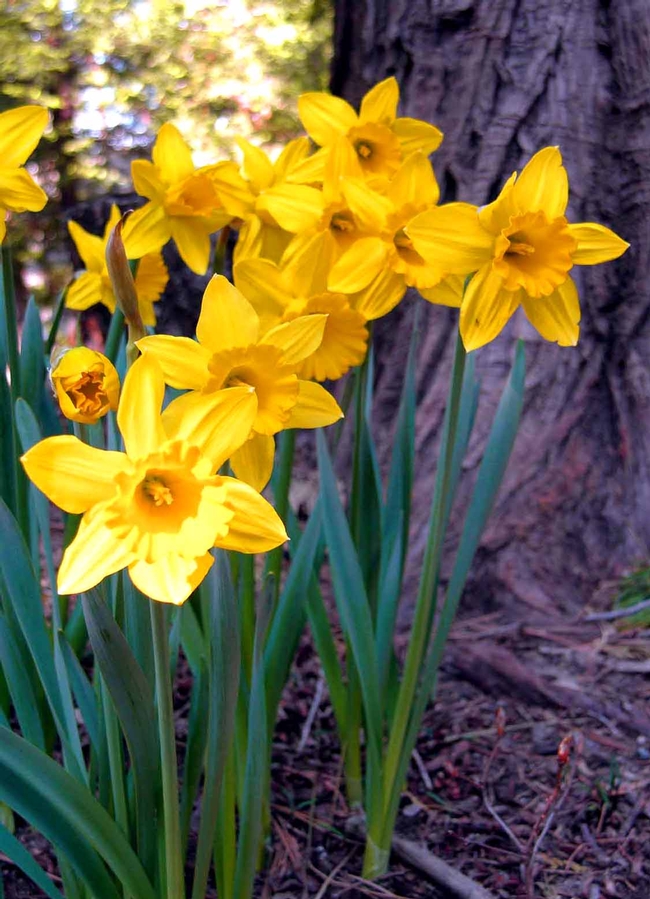They're everywhere in Spring, and they're beautiful: Daffodils (genus narcissus). There are countless species, and thousands of hybrids. These perennials multiply in two ways: by bulb division (asexual cloning), where the resulting flower is an exact copy of its predecessor; by seed (sexually), developed in the seed pod behind the petals, where different new flowers will result. Few seeds will naturally pollinate and it can take about five years for a bulb to form and the first flower to bloom. Daffodils are toxic and non-edible. Squirrels avoid eating daffodils, as should pets, because of poisonous crystals in the bulbs and leaves.
Spring
Bulbs are one of the first flowers to appear as temperatures slowly increase. Daffodils will generally last three weeks before they begin wilting and dying back. After the flower has wilted, the flower can be deadheaded. This helps focus the plant's energy on re-building the bulb for next year's flower, rather than sending energy to the seeds.
Don't cut back the leaves until they've totally died back. Bulbs need time after blooming to gather and store energy for next year's bloom. Bulb experts encourage watering the withering plant in dry conditions. This will help the bulbs draw in nutrients needed for the next season. Once the foliage is completely withered it's safe to trim back to soil levels. If the flowers did not perform well, consider applying a low-nitrogen, high-potash (potassium) fertilizer after flowering. Otherwise, add bone meal.
Bulb growth includes the production of smaller bulbs. It's a good idea to separate the bulbs every three to four years, providing them with the needed space to encourage larger, healthy blooms. After the leaves have died back, dig up the bulbs and gently pull the clumps apart. Remove dirt and debris and allow them to dry in a cool ventilated area. Save them for autumn planting. While smaller bulbs may not produce for a couple of years, larger bulbs will provide new flowers next season.
Summer
During this time the bulb stores the energy it has gathered and lies in wait for the next growing season. As summer comes to a close, local garden centers begin carrying one to three different varieties of daffodil bulbs. Consider buying bulbs directly from daffodil growers -- either through mail catalogues or the internet. Here you'll find countless amazing varieties. Daffodils come in a many colors, including yellow, orange, white, pinks and corals. Similar to a brown onion, newly purchased bulbs should be dry but not shriveled. A bulb should not have any sprouting leaves or roots, nor have moldy soft spots.
Autumn
Autumn is bulb planting time. Plant bulbs two to four weeks before first frost. Check packaging for planting instructions. In general, daffodils do best when planted in well-draining soil, in full or partial shade. Plant bulbs two to five times their own depth, three to six inches apart. Add a scant amount of bulb fertilizer to the soil, if needed. Wear protective gloves to avoid possible skin irritation.
Winter
During winter, the bulbs chill. This chill time is needed for the flower to bloom. With the advantage of cold winters, mountain gardeners can count on great daffodils each year. At lower altitudes, bulbs must be cured to experience the necessary chill time.
Bulb Curing Tips: Bulbs do best when cold-cured at 60 to 65°F, for 6 – 8 weeks. Gently separate clusters, trim roots, and allow bulbs to dry away from sunlight, about a day. A paper bag or other breathe-able wrapper is recommended. Refrigerator storage can work, but bulbs must be kept away from produce. Apples and other fruits emit ethanol gas that may kill dormant flowers. Bulbs kept cool and dry are ready for re-planting in late fall.
And the cycle begins.
